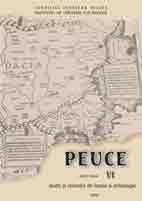About Figurines en violon within the Civilisation Gumelniţa – Karanovo VI
About Figurines en violon within the Civilisation Gumelniţa – Karanovo VI
Author(s): Valentina VoineaSubject(s): Archaeology
Published by: Institutul de Cercetari Eco-Muzeale Tulcea - Institutul de Istorie si Arheologie
Keywords: figurines ‘en violon’; Gumelniţa-Karanovo VI
Summary/Abstract: Previously published articles have mentioned various purposes for the bone-made en violon figurines belonging to the Gumelnita culture: arm guard for the archers or pieces used to stretch the bow string, bone anthropomorphic figurines related to the funerary practices or pieces from simple musical instruments. The diversity of the proposed interpretations is due to the „geometrized” shape of the human silhouette, as the profile is made up of simple vertical lines. Considering the lack of written sources, the most import clue for the figurines’ purpose is the archaeological context at the time of their finding. In the settlements, these artifacts were found together with other figurines, hence the obviousness of their religious role. The findings at the Varna necropolis suggest the same function. All eight en violon figurines, of which seven made of bone (M.1) and one of marble (M.3) were discovered in symbolic tombs. The accompanying artifacts (a vessel, a piercer and a flint knife) that surrounded the figurines suggest that the en violon figurine was played the main part in the ritual. What did this schematized human figurine symbolize: a celestial divinity, with the discoid shape of the head representing the solar disc or a protector spirit, similar to an angel? Can the accompanying artifacts be associated with shamanic practices? Even if, at the present state of the investigations, the answer to these questions is only hypothetical, however, we can state with certainty that the purpose of the figurines overpasses the limit of the fertility rituals. The bone-made en violon figurines constitute a chronological landmark, as the copying of the same shapes and dimensions could have been possible only for a short period of time. The discovery of the figurines in levels that were previously considered successive brings forth the problem of division into periods based only on pottery typology, without clear chronological reference points. In a previous article, we were underlying that the partial contemporaneousness relationship between phases Gumelniţa A2 final – Gumelniţa B1 – Varna III – Cernavodă I shouldn’t be considered impossible, as the accentuation of regional differences is normal in an agitated period with eastern influences.
Journal: Peuce (Serie Nouă) - Studii şi cercetari de istorie şi arheologie
- Issue Year: VI/2008
- Issue No: 6
- Page Range: 7-24
- Page Count: 19
- Language: English

